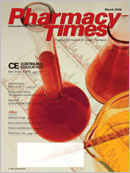Publication
Article
Pharmacy Times
Putting Acetaminophen Poisoning into Perspective
As pharmacists, we are not only"keepers" of drugs, but also "keepers"of an enormous wealth of therapeuticknowledge, which we use on a continualbasis to protect our patients fromharm. With the advent of the WorldWide Web and multimedia, our patientsare exposed daily to volumes of informationfrom a vast number of sources,some with questionable reliability. Aspharmacists, we have the responsibilityto act as an "information" filter,bringing clarity to a possibly overdramatizedsituation as portrayed in thelay press.
A case in point is an article thatappeared in the November 29, 2005,issue of the New York Times. The article,entitled "Poisonings from a PopularPain Reliever Are Rising," highlightsdata published in the December issueof Hepatology. In this newspaper article,the mass media used typical scaretactics to overdramatize acetaminophentoxicity. The authors included sensationalizedphrases, such as acetaminophenis a "grisly way to die" andthat it is "acetaminophen that kills theliver," in an effort to gain the attentionof the lay population.
Put into perspective, acetaminophenis a very safe and effective analgesicand antipyretic, when used in theappropriate doses and in the rightpatients. If patients follow the spirit ofthat article and avoid acetaminophenuse, they will be left with very fewalternatives for pain relief and fevercontrol. Of course, the New York Timeswill not be paying for patients' emergencyroom or provider visits.
The study published by Larson andcolleagues in the December issue ofHepatology suggested that 48% ofcases of acetaminophen-inducedacute liver failure were the result of anunintentional ingestion. OTC acetaminophenproducts were the sole sourcein 53% of all acetaminophen-inducedacute liver failure cases, and, of thisgroup of patients, 96% had consumedonly a single OTC product.
This study's patient population, however,was taken specifically from transplantcenters across the United States.Using this population introduces somebias into the study, because thesepatients most likely already had elevatedbaseline liver dysfunction or poormental status. Both of these characteristicsput this population at a higher riskfor potential acetaminophen toxicity.
Furthermore, the design of this studydid not restrict the diagnosis of acetaminophen-induced liver failure to theclassical models. Rather, it sought todefine the role of acetaminophen byadopting a broader set of diagnosticcriteria that included a history ofpotentially toxic acetaminophen ingestionof >4 g per day, the detection ofany level of acetaminophen in theserum, or a serum alanine aminotransferaseof >1000 IU/L irrespective of theacetaminophen level. The use of thesebroader criteria most likely resulted inthe inclusion of some cases that werenot truly acute liver failure related toacetaminophen.
Therefore, can we extrapolate thesedata to the entirety of patients we seewithin our pharmacies or health systems?The answer is most likely no.This study has both internal and externalvalidity issues.
Whereas the intent of the present articleis not so much to belittle the problemof acetaminophen overdose, its purposeis to bring the problem into the properperspective. One step in avoiding unnecessaryacetaminophen toxicity is adequatescreening and patient education.Rather than scaring the population atlarge, the New York Times should havefocused on the solution instead of dramatizingthe problem.
There are >200 products that containacetaminophen sold over thecounter in the United States, and thenumber of products grows even largerwhen all the prescription products thatcontain acetaminophen are included.The pharmacist is the only health careprofessional who is properly positionedto provide appropriate patient educationabout this agent.
So, as pharmacists, what should we bedoing? We should be paying close attentionto potential interactions with drugsthat induce the cytochrome P-450enzyme system, such as certain antibiotics,antiseizure medications, and cardiacmedications. Furthermore, not allpatients are candidates for acetaminophen.Patients who consume >3 alcoholicdrinks daily have conditions thatmay alter their ability to make informeddecisions, or have any liver dysfunctionsuch as cirrhosis should not be takingacetaminophen preparations. Finally, weneed to be detectives and investigate ourpatients' medication profiles for anyadditional sources of acetaminophen.
Dr. Imel is a pharmacy practice residentat University of Colorado (UC) Hospital.Dr. Page is an associate professor inthe Departments of Clinical Pharmacyand Physical Medicine at UC HealthSciences Center, Schools of Pharmacyand Medicine.







